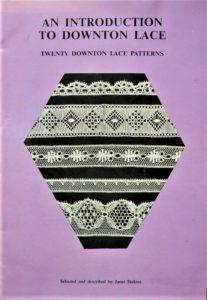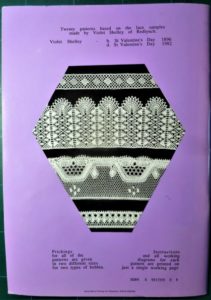Title: An Introduction to Downton Lace: twenty Downton lace patterns. Selected and described by Janet Stukins.
Author: Stukins, Janet.
Language: English.
Self-published, 1991. Softcover, 32 pages, illustrated.
ISBN 0-9517335-0-8.
An instructional booklet with 20 patterns, based on designs held by a lacemaker in Redlynch, Wilts. Edgings and several insertions (no corners), calling for 20-94 bobbins.
Black-and-white illustrations, both working diagrams and close-ups of finished lace. This was published before the era of colour photography and international colour-coded working diagrams, so the modern lace maker will have to work harder than usual and be particularly patient and flexible.
The Salisbury Museum contains the definitive archive of Downton Lace, mostly split between Torchon and Point Ground. There are however some very simple patterns, perhaps done by girls starting out on their careers as lacemakers, which combine the stylistic features of both. Stukins highlights these combined Torchon-Point Ground patterns in patterns numbers 1-8, so these will be especially useful for anyone with a background in Torchon transitioning to Point Ground. These patterns introduce gimp ‘fingers’, catch pins/reverse catch pins, and purl pins, but are especially useful in consolidating the Downton Whole Stitch (ctt pin ctt) used as a footside. Before moving to patterns #9 and beyond, take up the challenge of creating a faultless continuous DWS footside, especially next to Torchon grounds and using very fine thread. Patterns 20 and 20a look thoroughly like Flanders Lace (perhaps a throwback to its 17th-century origins) and juxtapose single-grid patterns (#19 and 20) creating an angular look, with a separate two-grid-in-one-prickings creating a more graceful and elegant look (#19a and 20a).
In Downton, the footside is on the left. Bertha Kemp’s book on Downton Lace also has the footside on the left, while Joan Blanchard’s book on Malmesbury Lace (indistinguishable from Downton) has her footsides are on the right.
Prickings are provided in a pull-out section on mauve paper in two sizes – one traditional (requiring 120+ thread plus pearl cotton 12 gimp) and one slightly larger (DMC Broder Machine 50 for Finca 80 and pearl cotton 8 gimp). All are of unequal length and drawn by hand. No corresponding names or numbers matching patterns in The Salisbury Museum are provided. Take care with the obvious error in the pricking half-way along in pattern 2. Don’t be tempted to reduce the large pricking of pattern 6 for 50 thread – with so much going on, you will appreciate the large grid.
Black-and-white photos of five laces on the front cover and five on the back – they are life-size, based on the large prickings for 50 thread.
Stukins crystallizes the wide variety of styles found in Downton Lace to just twenty examples – she does describe it as an “introduction” so lace makers will need to turn to other books to consolidate the techniques, for example, catch pins/reverse catch pins. This book is a much easier introduction to the lace style than Bertha Kemp’s book and complements similar patterns in Joan Blanchard’s book. I recommend working with all three books simultaneously to get a thoroughly rounded experience of Downton Lace before going off on your own, either to transcribe museum patterns based on internet images (e.g. the famous Downton Daisy pattern with its discontinuous gimps) or to create your own adapted Downton Lace patterns.
Rod 8/11/2020


